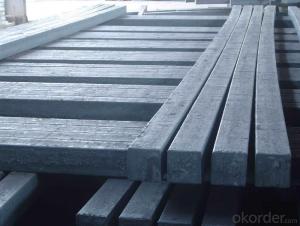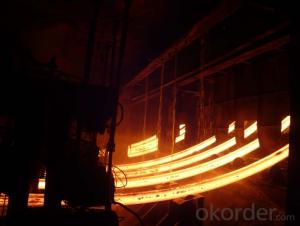Square Steel Billet Q235 3SP Grade Prime Quality 2#
- Loading Port:
- Tianjin
- Payment Terms:
- TT OR LC
- Min Order Qty:
- 2000 m.t
- Supply Capability:
- 50000 m.t/month
OKorder Service Pledge
OKorder Financial Service
You Might Also Like
Description of Square Steel Billet Q235 3SP Grade Prime Quality 2#
M. S. Billets are used for rolling of TMT Re-Bars of Fe415 and Fe500 Grade and various other structural steel products.
CRS Billets are used for rolling of CRS TMT Re-Bars.
Special Alloy Billets are used for rolling of any special grade TMT Re-Bars like Earthquake resistant TMT Re-Bars and for special grade structural steel products.
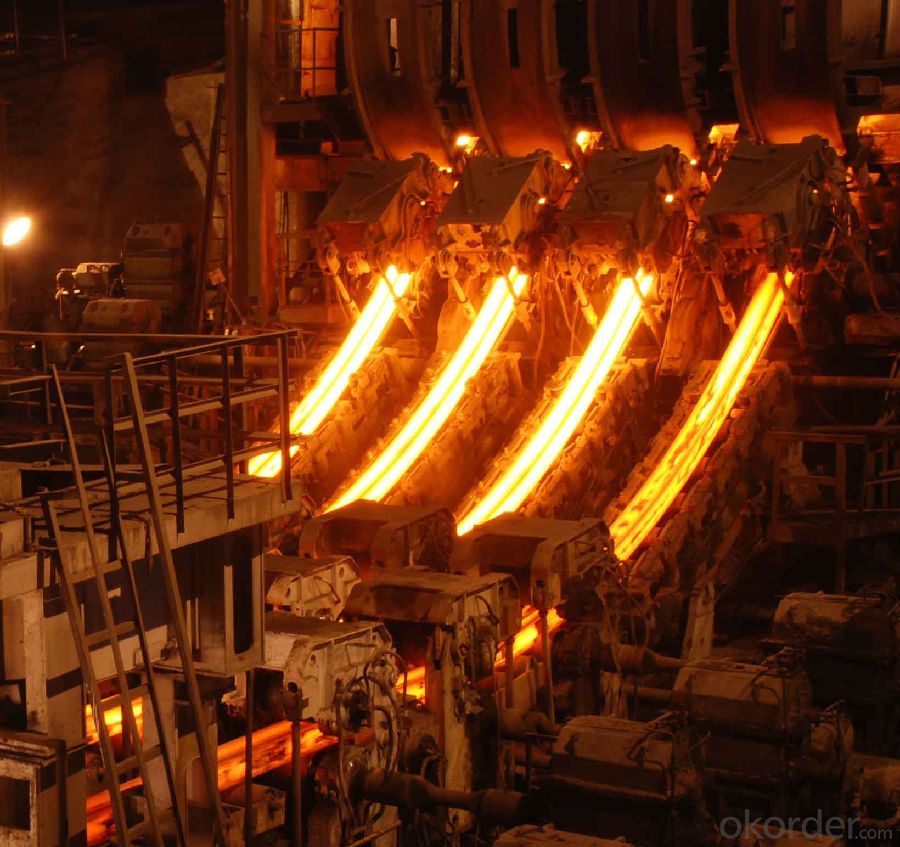
Main Feature Square Steel Billet Q235 3SP Grade Prime Quality 2#
Raw elements(C,Fe,Ni,Mn,Cr,Cu.)---Smelted ingots by AOD finery---hot rolled into black suface---pickling in acid liquid---cold drawn----polished by automatically machine--- cutting into pieces---checking quanlity
Applications of Square Steel Billet Q235 3SP Grade Prime Quality 2#
Widely Used in the areas such as Stainless Steel Fasteners, Chains, Kitchen and Sanitary wares, Furniture handles, Handrails, Electroplating and Electrolyzing pendants, Foods, Electron, Petroleum, Construction and Decoration, etc. Products have a high strength after cold-working. Electronic products parts, Medical appliance, Springs, Bus Inside and Outside packaging and building, Street Lamp Posts, etc. Decoration materials and Outdoor Publicity Billboard. Used for the products which have the Anti-Stress Corrosion requirement. Electron Products, Table-wares, Bolts, Nuts, Screen Meshes, Cumbustors and so on.
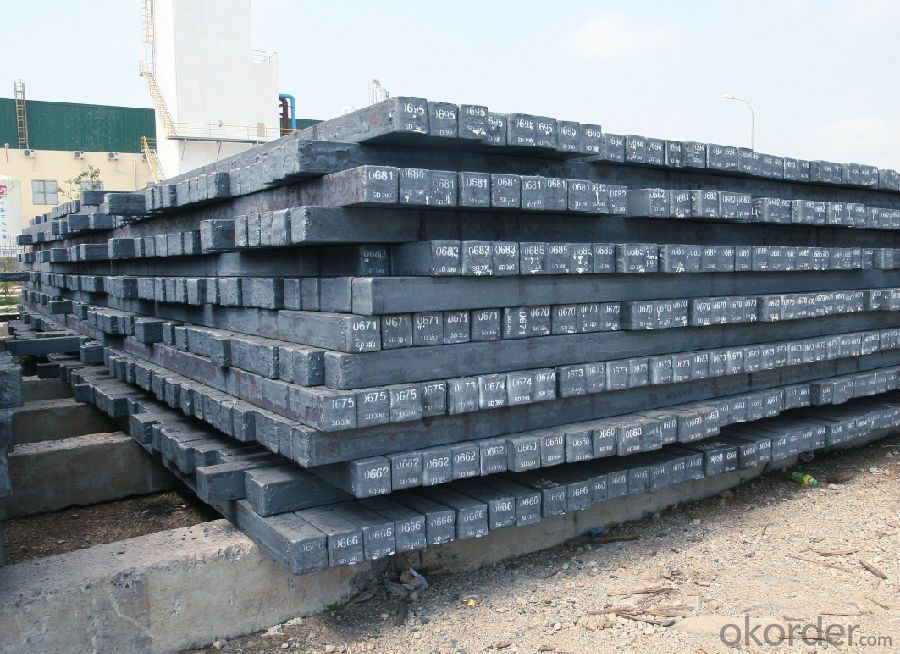
Specifications of Square Steel Billet Q235 3SP Grade Prime Quality 2#
| Standard | C(%) | Mn(%) | S(%) | P(%) | Si(%) |
| Q195 | ≤0.12 | ≤0.50 | ≤0.040 | ≤0.035 | ≤0.30 |
| Q235 | ≤0.20 | ≤1.40 | ≤0.045 | ≤0.045 | ≤0.35 |
| Q275 | ≤0.22 | ≤1.50 | ≤0.045 | ≤0.045 | ≤0.35 |
| 20MnSi | 0.17-0.25 | 1.2-1.6 | ≤ 0.050 | ≤ 0.050 | 0.40-0.80 |
| 3SP | 0.14-0.22 | 0.40-0.85 | ≤ 0.050 | ≤ 0.040 | 0.05-0.15 |
| 5SP | 0.28-0.37 | 0.50-1.00 | ≤ 0.050 | ≤ 0.040 | 0.15-0.30 |
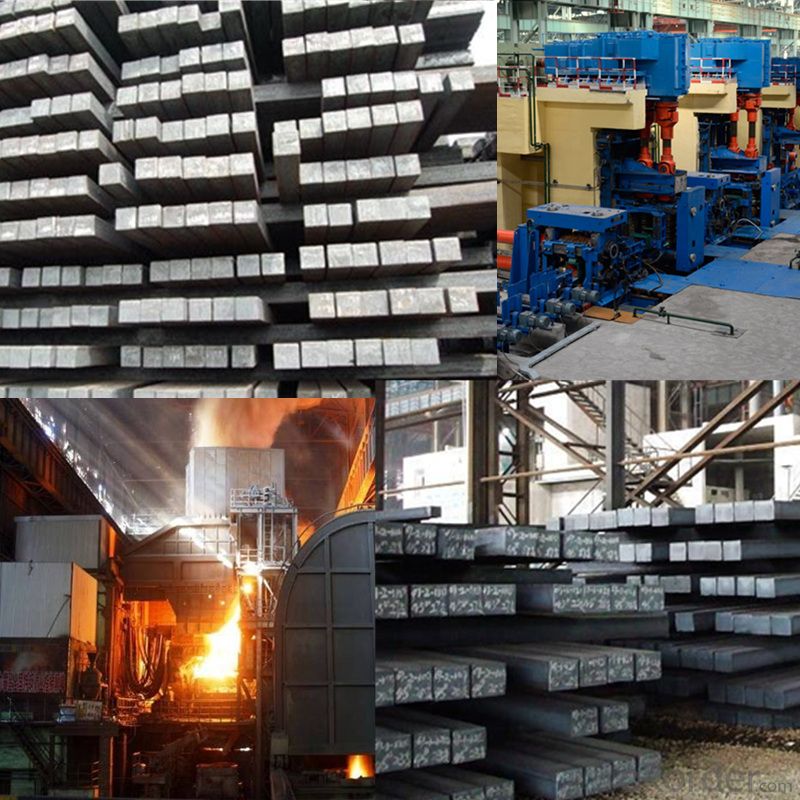
FAQ of Square Steel Billet Q235 3SP Grade Prime Quality 2#
We have organized several common questions for our clients,may help you sincerely:
1. How Can I Visit There?
Our company is located in Tianjin City, China, near Beijing. You can fly to Tianjin Airport Directly. All our clients, from home or aboard, are warmly welcome to visit us!
2. How Can I Get Some Sample?
We are honored to offer you sample.
3. Why choose CNBM?
Our delivery time about 15-20days for standard sizes, if you have other requirements like hardness, quanity and width ,it is about 20-40days. But don't worry we also try our best for the delivery time ,because time longer and our cost is higher.
- Q:What are the different types of non-destructive testing methods used for steel billets?
- There are several different types of non-destructive testing methods used for steel billets. These methods are employed to ensure the quality and integrity of the billets without causing any damage or alteration to the material. Some of the commonly used non-destructive testing methods for steel billets include: 1. Ultrasonic Testing (UT): This method uses high-frequency sound waves to detect internal defects or inconsistencies within the steel billets. UT can identify issues like cracks, voids, and inclusions that may affect the billet's strength and performance. 2. Magnetic Particle Testing (MPT): MPT involves the use of magnetic fields and magnetic particles to detect surface and near-surface defects in the steel billets. This method is particularly effective for identifying cracks, seams, and other discontinuities that may not be visible to the naked eye. 3. Eddy Current Testing (ECT): ECT utilizes electromagnetic induction to assess the quality of steel billets. It can detect surface and near-surface defects, such as cracks and corrosion, by measuring changes in electrical conductivity and magnetic fields. 4. Visual Inspection: Visual inspection is a basic non-destructive testing method that involves a thorough visual examination of the steel billets. It aims to identify any visible defects, such as surface cracks, dents, or irregularities in shape or size. 5. Penetrant Testing (PT): PT involves applying a liquid or fluorescent dye to the surface of the steel billets. The dye seeps into any surface defects, and after a certain time, excess dye is removed, and a developer is applied to make the defects visible. This method is useful for detecting surface cracks, porosity, and other surface irregularities. 6. Radiographic Testing (RT): RT uses X-rays or gamma rays to penetrate the steel billets and produce an image that can reveal internal defects. This method is highly effective for detecting cracks, inclusions, and voids within the billets. Each of these non-destructive testing methods plays a crucial role in ensuring the quality and reliability of steel billets. By employing a combination of these techniques, manufacturers can identify any potential defects or inconsistencies and take appropriate measures to rectify them, thereby ensuring the safety and performance of the steel billets in various applications.
- Q:How are steel billets used in the manufacturing of machinery?
- Steel billets are an essential component in the manufacturing of machinery due to their versatility and strength. These cylindrical metal bars, typically made from carbon or alloy steel, serve as the raw material that is transformed into various machine parts and components. One common application of steel billets in machinery manufacturing is for the production of machine frames and structures. The billets are heated and then hot-rolled or forged into the desired shape, ensuring the final product has the necessary strength and durability to withstand the mechanical stresses it will encounter during operation. Additionally, steel billets are used to create machine components such as gears, shafts, and axles. These parts require high tensile strength and resistance to wear and deformation, making steel billets the ideal material choice. The billets are typically machined or forged into the desired shape, ensuring precise dimensions and tolerances are met. Furthermore, steel billets can also be used in the manufacturing of machine tools, which are crucial for shaping and machining various materials. By using steel billets as the base material, machine tools can effectively handle heavy loads, provide stability, and ensure precision in the manufacturing processes. In summary, steel billets are integral to the manufacturing of machinery, as they provide the necessary strength, durability, and versatility required for the production of machine frames, components, and tools. Their ability to be shaped, machined, and forged into various forms allows for the creation of high-quality machinery that can effectively perform its intended functions.
- Q:What are the different surface treatment options for steel billets?
- There are several different surface treatment options available for steel billets, depending on the specific requirements and applications. Some of the common surface treatment methods for steel billets include: 1. Pickling: This process involves immersing the steel billets in an acid solution to remove any scales or impurities on the surface. Pickling helps to improve the surface finish and prepare the steel for further treatment or processing. 2. Shot blasting: Shot blasting is a mechanical process that involves propelling small steel shots at high velocity onto the surface of the billets. This treatment helps to remove rust, scales, and other contaminants, resulting in a clean and smooth surface finish. 3. Phosphating: Phosphating is a chemical treatment method that involves applying a phosphate coating onto the steel billets' surface. This process helps to improve corrosion resistance, enhance paint adhesion, and provide a uniform surface for subsequent treatments. 4. Galvanizing: Galvanizing is a popular surface treatment option where a layer of zinc is applied to the steel billets' surface through a hot-dip or electroplating process. This treatment provides excellent corrosion resistance, making it suitable for outdoor applications. 5. Coating: Steel billets can be coated with various materials, such as epoxy, polyurethane, or powder coatings, to enhance their appearance, provide additional corrosion protection, or improve resistance to wear and tear. 6. Passivation: Passivation is a chemical treatment process that aims to remove any free iron or iron oxide from the steel billets' surface and form a protective oxide layer. This treatment helps to increase corrosion resistance and improve the billets' overall performance. It is important to consider the specific requirements and intended use of the steel billets when selecting the appropriate surface treatment method. Factors such as corrosion resistance, appearance, adhesion, and wear resistance should be taken into account to ensure the desired performance and longevity of the steel billets.
- Q:How are steel billets used in the production of automotive parts?
- Steel billets are commonly used in the production of automotive parts as they serve as the raw material for forging, rolling, or extruding processes. These billets are heated and shaped into various forms such as rods, bars, or sheets to create components like engine parts, suspension systems, and body frames. The high strength and durability of steel make it an ideal choice for manufacturing automotive parts, ensuring safety and performance in vehicles.
- Q:What are the different shapes and sizes of steel billets?
- Steel billets come in various shapes and sizes, including square, round, rectangular, and hexagonal. The sizes of steel billets can range from small dimensions, such as 100mm x 100mm, to larger dimensions, such as 400mm x 400mm. These different shapes and sizes of steel billets serve different purposes and can be used in various industries, including construction, manufacturing, and automotive.
- Q:What is the role of steel billets in the manufacturing of construction cranes?
- In the manufacturing process of construction cranes, steel billets play a vital role as they are the raw materials used to produce various crane components. These billets are essentially partially finished steel products that are shaped and sized into rectangles or squares. A primary purpose of steel billets in crane manufacturing is the production of structural members like beams, columns, and braces. These components provide the necessary strength and stability to support the crane's weight and the loads it carries. Steel billets are chosen for their high strength and durability, enabling the crane to withstand heavy loads and adverse working conditions. Furthermore, steel billets are utilized to manufacture the crane's boom, jib, and lifting mechanisms. These parts experience significant stress and forces during crane operation, and the superior mechanical properties of steel billets make them ideal for ensuring the crane's structural integrity and longevity. Additionally, steel billets are used in the fabrication of counterweights for the crane. Counterweights are crucial for balancing the load being lifted and preventing the crane from tipping over. By using steel billets, manufacturers can create counterweights that are sufficiently heavy to counterbalance the loads without compromising the overall stability and safety of the crane. Moreover, steel billets are often employed in the production of other crane components such as pins, bolts, and connectors. These small yet essential parts contribute to the overall performance and functionality of the crane, ensuring smooth operation and structural integrity. In summary, steel billets act as the fundamental building blocks for the manufacturing of construction cranes, providing the necessary strength, durability, and stability required for these robust machines. Without steel billets, it would be nearly impossible to produce cranes capable of lifting heavy loads and withstanding the demanding conditions of construction sites.
- Q:How does the composition of steel affect the properties of steel billets?
- The properties of steel billets are determined by the composition of steel, which is a critical factor. Steel is primarily composed of iron and carbon, with small amounts of other elements like manganese, silicon, and sulfur. The physical and mechanical properties of steel billets are greatly influenced by the percentage of carbon and the presence of other alloying elements. Strength is one of the key properties affected by the composition of steel. By increasing the carbon content, the strength of steel is enhanced, making it suitable for applications that require high tensile strength, such as construction beams and automotive parts. The presence of alloying elements like manganese and silicon can also improve the strength and hardness of steel. Ductility and toughness are also affected by the composition of steel. Ductility refers to the ability of steel to deform under tensile stress without fracturing, while toughness is its ability to withstand impact and resist fracture. Higher carbon content tends to reduce ductility and toughness, making the steel more brittle. Therefore, for applications that require good ductility and toughness, it is preferred to have lower carbon content and the addition of alloying elements like nickel, chromium, and molybdenum. The composition of steel also influences its corrosion resistance. The addition of elements like chromium and nickel can significantly enhance the steel's resistance to corrosion, making it suitable for applications in harsh environments or exposed to corrosive substances like seawater. Stainless steel, for example, contains a high percentage of chromium, which forms a protective oxide layer on the surface, preventing corrosion. Machinability and weldability are other properties affected by the composition of steel. Higher carbon content may reduce machinability due to increased hardness, while alloying elements like sulfur and phosphorus can improve machinability. Similarly, certain elements can affect the weldability of steel, as they may cause cracking or other defects during welding. In conclusion, the composition of steel billets has a significant impact on their properties. The percentage of carbon and the presence of other alloying elements influence the strength, ductility, toughness, corrosion resistance, machinability, and weldability of steel. Therefore, it is crucial to carefully consider the desired properties and select the appropriate steel composition for various industrial applications.
- Q:How are steel billets used in the manufacturing of oil and gas equipment?
- Steel billets are used in the manufacturing of oil and gas equipment by being shaped and formed into various components such as pipes, valves, and fittings. These billets are heated and then forged, molded, or rolled to create the required shapes and dimensions. The resulting steel components possess high strength, durability, and corrosion resistance, making them suitable for the harsh conditions encountered in the oil and gas industry.
- Q:What are the causes of internal cracks in continuous casting billet?
- A French Research Institute of carbon, sulfur and phosphorus influence on continuous casting billet hot cracking, a total of three test groups of carbon manganese steel, carbon, sulfur and phosphorus content of each sample is different.
- Q:How is the quality of steel billets ensured during the manufacturing process?
- The quality of steel billets is guaranteed by implementing strict testing measures and adhering to industry standards throughout the manufacturing process. There are several crucial steps involved in maintaining the quality of steel billets: 1. Inspection of Raw Materials: Initially, the raw materials, typically iron ore and/or scrap metal, undergo careful scrutiny to ensure they meet the necessary specifications. This involves examining impurities and verifying the chemical composition. 2. Melting and Refining: The raw materials are melted in a furnace and impurities are eliminated through refining techniques like desulphurization and degassing. This process improves the quality of the steel by reducing unwanted elements and enhancing its overall purity. 3. Casting: Subsequently, the refined steel is cast into billet form using a continuous casting process. This method guarantees uniform size and shape of the billets, which is crucial for further processing. 4. Non-Destructive Testing: Throughout and after the continuous casting process, various non-destructive testing methods, including ultrasonic testing, magnetic particle inspection, and visual inspection, are employed to assess the integrity of the billets. These tests identify any defects or imperfections that may compromise the quality of the billets. 5. Heat Treatment: Depending on the desired properties of the final steel product, the billets may undergo heat treatment processes like annealing, quenching, or tempering. These procedures further enhance the strength, hardness, and other mechanical properties of the steel. 6. Final Inspection: The finished steel billets undergo a final inspection to ensure they meet the required specifications. This involves assessing their dimensions, surface quality, and mechanical properties. Typically, samples from each batch are subjected to destructive testing to confirm their strength and other properties. 7. Traceability and Documentation: It is essential to maintain proper traceability and documentation of all quality-related activities throughout the manufacturing process. This includes recording test results, maintaining batch records, and ensuring accurate identification and labeling of the billets. By adhering to these rigorous procedures and conducting various tests, manufacturers can guarantee the maintenance of steel billet quality at every stage of the manufacturing process. This ensures that the final steel products made from these billets will meet the required standards and perform as intended in various applications.
1. Manufacturer Overview |
|
|---|---|
| Location | |
| Year Established | |
| Annual Output Value | |
| Main Markets | |
| Company Certifications | |
2. Manufacturer Certificates |
|
|---|---|
| a) Certification Name | |
| Range | |
| Reference | |
| Validity Period | |
3. Manufacturer Capability |
|
|---|---|
| a)Trade Capacity | |
| Nearest Port | |
| Export Percentage | |
| No.of Employees in Trade Department | |
| Language Spoken: | |
| b)Factory Information | |
| Factory Size: | |
| No. of Production Lines | |
| Contract Manufacturing | |
| Product Price Range | |
Send your message to us
Square Steel Billet Q235 3SP Grade Prime Quality 2#
- Loading Port:
- Tianjin
- Payment Terms:
- TT OR LC
- Min Order Qty:
- 2000 m.t
- Supply Capability:
- 50000 m.t/month
OKorder Service Pledge
OKorder Financial Service
Similar products
New products
Hot products
Related keywords


